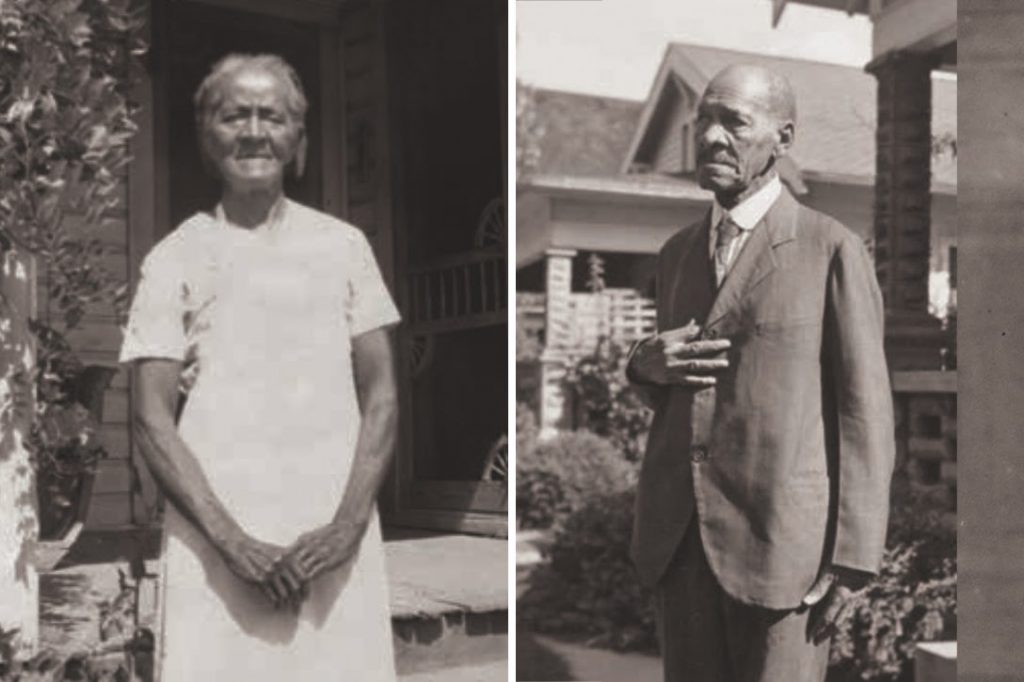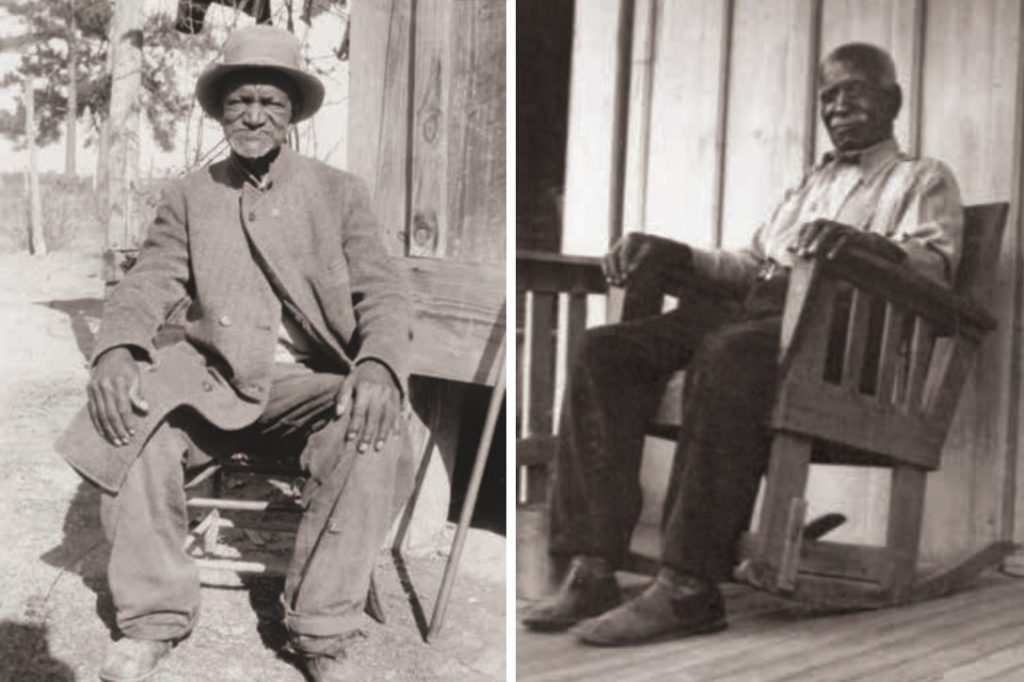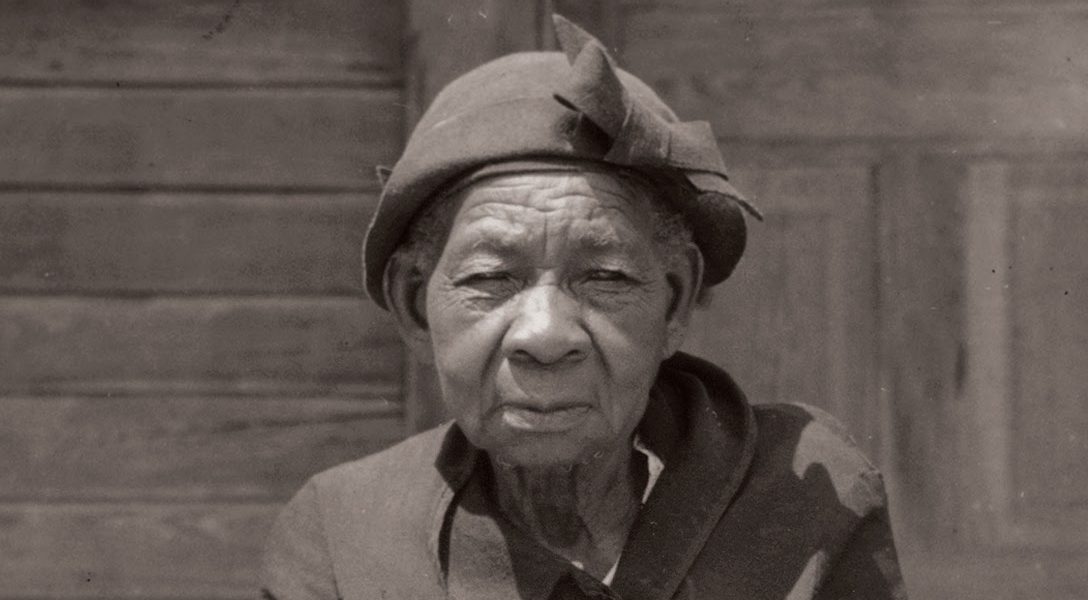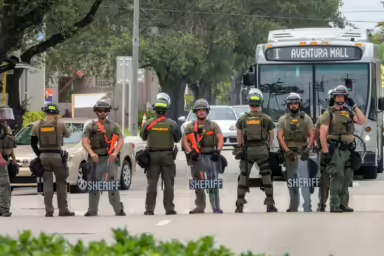Former Chicago Sun-Times photo editor Richard Cahan shares powerful images and comments of formerly enslaved African Americans.
Some 70 years after emancipation, a team of unemployed writers and journalists located over 300 formerly enslaved African Americans, captured their unvarnished stories about life under slavery, and took photo portraits of many of their subjects.

Their work is the subject of a new book whose publication coincides with the start of Black History Month. River of Blood brings the reader candid and searing comments that were captured verbatim in the original dialects of the Deep South. Laying bare the pain and humiliation of their treatment, their voices describe the relentless degradation they were subjected to every day: whippings, being fed like hogs, and brutal separations from their loved ones when they were sold as “chattel property” at auctions or transferred to new owners as wedding gifts.

Richard Cahan, retired photo editor of the Chicago Sun-Times, co-edited this powerful volume with Michael Williams, and shares these important stories from River of Blood in this podcast.
*River of Blood: American Slavery From the People Who Lived It: Interviews & Photographs of Formerly Enslaved African Americans (CityFiles Press, January 2020), edited by Richard Cahan and Michael Williams, features photos by Dorothy Lange and a foreword by Adam Green.



Click HERE to Download Mp3
Full Text Transcript:
As a service to our readers, we provide transcripts with our podcasts. We try to ensure that these transcripts do not include errors. However, due to time constraints, we are not always able to proofread them as closely as we would like. Should you spot any errors, we’d be grateful if you would notify us.
| Peter B. Collins: | Welcome to another radio WhoWhatWhy podcast. In San Francisco, I’m Peter B. Collins. Today I’m joined by Richard Cahan. |
| Peter B. Collins: | He is the former photo editor of The Chicago Sun-Times. And in recent years, together with Michael Williams, he has co-edited a series of books with very important archived and historic photographs, and they all center around fairly troubling themes. |
| Peter B. Collins: | I first talked to Rich when they published the book, Un-American: Photos of the Incarceration of Japanese Americans During World War II. In 2019, they published Aftershock: The Human Toll of War, with haunting World War II images that were taken by soldier photographers. |
| Peter B. Collins: | And the latest publication is a powerful book called River of Blood: American Slavery from the People Who Lived It. Rich Cahan, thanks for joining us today. |
| Rich Cahan: | Thank you, Peter, very much. |
| Peter B. Collins: | You have done remarkable work here, as I say, in some cases, unearthing photos that may have been lost through history, and as collections get shuffled from one place to the next, and the people who knew the details of them pass away or move away. And so, today, we’re talking about this powerful collection of photographs, with quotations from the individuals. |
| Peter B. Collins: | These are people who were once slaves in the United States of America, and survived the Emancipation, and often lived well into the 20th Century. So tell us about where these photos came from, and the Works Projects Administration project from the 1930s Depression, that produced the original images, and the capturing of the quotes from the people who were photographed. |
| Rich Cahan: | Well, imagine for a moment, a government that cares enough about people, that they find it worthwhile to create a branch of government, that would go out and interview 10,000 ordinary Americans, and also interview 3,000 formerly enslaved African-Americans. That was what the Works Progress Administration did in the 1930s, and we’re focusing on a group of interviews that was done primarily in 1937 and ’38, in mostly Southern states. But they did get to about 25 states. |
| Rich Cahan: | And they literally, they knew that enslaved people were not going to be living much longer. This was 70 years after the end of the Civil War. And so they knocked on doors, the interviewers, and asked people about their experiences as slaves. |
| Rich Cahan: | And they created something called The Slave Narrative Collection, which is an incredible work in itself, but forgotten by many are the photographs that they took of over 300 formerly enslaved men and women, and what this book, River of Blood, is. |
| Rich Cahan: | It’s a look at those photographs, those beautiful portraits, with excerpts from the testimony that these men and women gave. And I think that there’s a great power when you combine words and pictures. And by reading the words, it’s important, by looking at the pictures, it’s important, but they’re almost supercharged when you combine them together. |
| Peter B. Collins: | Well, and Rich, just personally, I got the book shortly after I had watched the currently released movie ‘Harriet’, which is focused on Harriet Tubman, the Underground Railroad, and Cynthia Erivo does an incredible job portraying Harriet. |
| Peter B. Collins: | The movie is gripping and graphic in many places. And we see the true interaction of slaves and the masters on a plantation, the urge to escape, the perils that were visited upon people who did make that effort. |
| Peter B. Collins: | And so, this, I think, is such an important piece of American history, and this brings to life the people who survived the slave era. Tell us a little bit about the individuals who were sent out to locate these people and interview them. |
| Rich Cahan: | Well, they were somehow related to the humanities. Many of them were writers that used to work for newspapers. Remember, this is the Depression, and many newspapers contracted. There were few books being produced. |
| Rich Cahan: | And so, these were writers, primarily, who didn’t have any other work, and so, they contracted with the federal government, sometimes for years. Some great writers, Nelson Algren, Richard Wright, worked for the Works Progress Administration. And they were curious, they were interesting, and it’s amazing. |
| Rich Cahan: | Most were white, and they were viewed with suspicion, by these people who were former slaves. These people were living in shacks sometimes, and all of a sudden, a white man or a white woman knocks on their door, and says that they’re interested in their recollections of what slave life was like. You would think that they would be met with great suspicion, but people, the elderly people who were interviewed, were precise. |
| Rich Cahan: | They talked eloquently. And then, there was this moment, for some of them, that they actually had their photographs taken. And I think it came after reading the transcripts, it looks like the interviews were usually about an hour long. And then, at the end, I presume, the photographer says, “Do you mind if I take your picture?” And they each struck kind of a beautiful pose. |
| Rich Cahan: | One woman stood among her flowing sheets that she was just doing in the, that were drying outside on the back of her lawn. Many people just kind of lean back on the rocking chair on their porch. Somebody was photographed in the middle of a field. A few people who had moved up North, in Cincinnati, like Richard Toler, who’s the cover person on the book, posed on a cobblestone street. And these pictures are so simple and real and authentic. |
| Rich Cahan: | They’re not professional photographers. This isn’t Dorothea Lange taking these pictures, but it’s a snapshot portrait of what they look like. And there’s, just like, snapshots sometimes have more meaning than professional pictures. So you can imagine, I’m sure many listeners had their families photographed by professional photographers. But it’s the little snapshots that have even greater meaning oftentimes of life. And that’s what this book is based on. |
| Peter B. Collins: | And do you know what kind of cameras they use? Did the government issue Brownies to… |
| Rich Cahan: | I think they were all using Brownie cameras, which were the camera of the day. Their negatives are lost, just prints. And those prints were never really valued that much there. You can tell that, because they have little paper clips, oftentimes, on them, sticking to the pages of the transcript. But with today’s technology, you can take these little snapshots and really look at them in a beautiful light. They’re there, they’re not printed huge. You have to kind of study them. |
| Rich Cahan: | But when you study them, there’s so many little details of what they wore, and what their houses look like, and what their surroundings look like, that they really elevate the words, excuse me, elevate the words in a beautiful manner. |
| Peter B. Collins: | Go ahead and clear your throat. |
| Rich Cahan: | Yeah. I don’t know if people would be that interested in the pictures on their own. I don’t know if people would be that interested in the words on their own, but together, those words and pictures work together to create power. |
| Peter B. Collins: | And Rich, these individuals hired by the government, who went out to conduct these interviews, many of them captured the comments in the vernacular. And you went to great lengths to try to bring that to the book, so that the reader does hear their voices in a truly authentic way. |
| Rich Cahan: | That was one of our first challenges. Do we keep the vernacular? Or do we, I’m putting quote marks up, do we “translate” them into what would be considered modern English? And the answer obviously was to keep the words as they were transcribed, because A, they’re historical, and I’m not interpreting what they mean, but I fell in love with the language. |
| Rich Cahan: | This is the language of the rural South, I think, black and white. I don’t think there’s anything particularly African-American about them. I think whites in the rural South, in those years, talked very similarly. And there’s a great beauty to it. |
| Rich Cahan: | I remember being in high school, and reading Huckleberry Finn for the first time, and like all students, I said, “Oh no, I don’t understand that. I can’t read this.” And my teacher, like most teachers, said, “You have no choice. You just have to figure it out.” And within days at that time, hours at that time, I figured it out. And the same thing here. |
| Rich Cahan: | I think you figure it out after a couple of passages. And if you don’t, we’ve provided a glossary. But once you figure it out, you realize that there’s a beauty to that language that I’m so happy to have, has not been lost, |
| Peter B. Collins: | And Rich, one of the challenges you face, and I’m dealing with it right here, right now, trying to be correct and respectful, and there’s often self-reference, using the N-word. |
| Rich Cahan: | Yup. |
| Peter B. Collins: | And certainly, it was commonly used, both in a derisive way, and in just a labeling way. And when an African-American person refers to him or-herself using the N word, I certainly respect that. And I take no offense, and I’m certain most African-Americans wouldn’t either. But there is the awkward situation, that when white people even just quote verbatim, the actual statements that some of the people are quoted as making in the book, it doesn’t play well. |
| Rich Cahan: | I agree. I think that, we had no choice, because we were faithful to the documents. But I think when you talk about, when I talk about the book, I’m not going to use that word. I don’t think that’s appropriate. And I think that’s okay. I think, if I said those words, I think that I would be calling more attention to the words, than what’s, the words, the importance of what’s surrounding the words. |
| Rich Cahan: | And so, it is in the book, and it was important. We had no choice in the book, but I think, in discussions of it, I would leave it alone, personally. |
| Peter B. Collins: | Sure, yeah. Well, let me read here one that doesn’t include any of those challenges. This is John M. Fields, who in the little description, he was born into slavery, 1848, in Owensboro, Kentucky. Escaped in 1864, tried to join the Union Army, but was refused, because of his age. He then moved to Lafayette, Indiana, and worked as a labor and household servant, and he died in 1953. So he lived more than a hundred years, if his birthdate is accurate. |
| Rich Cahan: | Right. |
| Peter B. Collins: | And let me read his statement here: “When I was six years old, all of his children were taken from my parents, because my master died, and his estate had to be settled. We slaves were divided by this method. Three disinterested persons were chosen to come to the plantation, and together, they wrote the names of the different heirs on a few slips of paper. These were put in a hat passed among us slaves. Each one took a slip, and the name on the slip was the new owner. |
| Peter B. Collins: | “I happened to draw the name of a relative of my master, who was a widow. I can’t describe the heartbreak and horror of that separation. I was only six years old, and it was the last time I ever saw my mother for longer than one night.” And these brief but powerful descriptions really help us who never experienced slavery, or even the legacy of it, get some sense of what kind of inhumanity was visited on these humans on a regular basis. |
| Rich Cahan: | I agree with you. I think one of the problems with our education, is that we learn about slavery in kind of political terms. We talk about Dred Scott, we talk about the North and the South. We learn about it in kind of economic terms. They talk about the cotton looms, and how the North sold, and took the cotton, and they depended on that too. And somehow, the humanity, this single humanity, human story seems to get lost. And I think that’s the greatest value of this collection. |
| Rich Cahan: | For a long time, these people were interviewed in the 1930s, and I think people today forget that oral history was really looked down upon, or considered suspicious by, especially, academicians, until really… I’m a Chicagoan, so I think it’s until Studs Terkel really, brought it to, elevated it to a height, that I think oral history is now sometimes more valued than written history. And so, that’s why this material has been so neglected for so many years. |
| Peter B. Collins: | Well, I agree with you about Studs Terkel. And when I worked in Chicago in the 1970s, I had another, a number of encounters with him, and it was always very pleasant and enjoyable. And his work, I think, continues to provide valuable legacies. |
| Peter B. Collins: | Again, in the spoken word, which is…It has so many qualities, that go beyond the kind of stale historic writing that does give you an accurate list of the facts and people involved, but little of the nuance and personal interpretation. |
| Rich Cahan: | I agree. People talk a little bit about how the South pushed the plantation myth, that African-Americans were happy on plantations as slaves, that they were sheltered, that they were fed, and the histories of a century ago really depended on plantation records. |
| Rich Cahan: | And if you just looked at those records, it would paint a picture that is completely out of kilter, you know? Totally, totally false, because you would see how much was spent on clothes and food and things like that. |
| Rich Cahan: | But the reality is what people really, how they were affected. And I was amazed that the people that were interviewed for this project had such clear memories of those days. And obviously they should. As we get older, our memories of the past sometimes become even clearer, and they were so willing to share that, in great detail. |
| Peter B. Collins: | Rich, one of the chilling quotes I’m about to read here, refers to a human being as a chattel. And chattel is a kind of arcane legal term referring to property. And generally, it’s insignificant property. It’s like my grandmother’s dresser, or something like that. |
| Peter B. Collins: | And this is a quote from Sarah Frances Shaw Graves. She was born into slavery in 1850 near Louisville. She and her mother were forcibly moved to Missouri, to work for another slaveholder. Her father, never again seen by the family, was left behind in Kentucky. And she lived until 1942. |
| Peter B. Collins: | Here’s her quote: “You see, there were slaves in those days, just like you got horse and mule and auto traders now. They bought and sold slaves and hired them out. Yes, rented them out, a lot. It means something like hired out, but the slave never got no wages. That all went to the master. The man they were allotted to paid the master. I was never sold. My mama was sold only once, but she was hired out many times. Yes, when a slave was allotted, somebody made a down payment, and gave a mortgage for the rest, a chattel mortgage. Times don’t change, just the merchandise.” |
| Rich Cahan: | I love that last line. It shows how even as children, these enslaved men and women knew what was happening. There’s so many lines like that in the book, so many little moments of insight, that almost every quote ends like that. |
| Peter B. Collins: | Here’s James Martin on a similar, in a similar vein: “We see others sold on the auction block. They’re put in stalls, like pins for cattle. There’s a curtain, sometimes just a sheet in front of them, so the bidders can’t see the stock too soon. The overseer’s standing just outside with a big blacksnake whip, and a pepperbox pistol in his hand. When they pull the curtain up, and the bitter crowd, crowds around, the overseer tells the age of the slaves and what they can do.” |
| Peter B. Collins: | “One bidder takes a pair of white gloves they have, and rubs his fingers over a man’s teeth, and he says, ‘You say this buck’s 20 years old, but there’s cups worn to his teeth. He’s 40, if he’s a day.'” So they knocked that buck down for $1,000, because they called the men bucks, and the women winches. Then the overseer makes them walk across the platform. He makes him hop, he makes them trot, he makes them jump.” |
| Peter B. Collins: | And Rich, this brings to mind the way Roger Ailes made his female anchors twirl in front of him, treating them as a kind of a wage slave, if you will. |
| Rich Cahan: | Wow. That’s interesting. |
| Peter B. Collins: | But this treatment is really chilling, and to see the way they were reduced to the level of animal stock. |
| Rich Cahan: | I agree. And that’s, the book has kind of, it delves down into the deepest, darkest secrets of slavery. Things like this, things about enslaved people put in dungeons, and obviously, whippings and things like that. |
| Rich Cahan: | But I think, and I hope you feel the same way, Peter, that the book ends up being a book about resilience and beauty, and love of family. That is a theme that never, the Civil War ends, and people tell about how they went back to the South to find their mothers or their families, about how families were split up, but they kept sneaking back into plantations to be together. Did you feel this way? I’m interested in your response to the book and what struck you. |
| Peter B. Collins: | Well, really, it’s the dignity of these former slaves, who certainly survived, and lived to see their freedom, and to revel in that, without forgetting the depths of the indignities that they faced. And I also think, that what comes through, is the inner strength that was required to survive. |
| Rich Cahan: | Yes. |
| Peter B. Collins: | And that, to me, is the intangible that really comes through so strongly from the book. |
| Rich Cahan: | I agree with you. And there’s lots of stories of that, about singing in the fields, and determination, to just keep going. Fannie Moore has a quote. She died in 1940, and she just talked about how, all of a sudden, her mother had this kind of revelation that she was going to be okay. And she started working harder and harder in the field. And the plantation owner questioned her, “What’s going on here? There’s something going on.” |
| Rich Cahan: | And she said, “I’ve been saved. The Lord has told me that I’ll be saved.” And she said that, “One day we will never be slaves.” And of course, the plantation owner, hearing this grabbed a cow hide, and slashed her mother, but then it says, she, this woman recalled, “She’d just go back to the field to sing it.” Just the strength. |
| Peter B. Collins: | Well, and if I can connect it once again to this new film, ‘Harriet’, I don’t want to spoil it for people, but there is a powerful scene, where Harriet has the upper hand on her former master, and she could kill him. And instead she chooses to tell him that she’s free, in simple terms. |
| Peter B. Collins: | It’s a more powerful and detailed scene than that. But her, at least the way that storyline is played in the movie, really plays up the deep spirituality, and their sense of Christian forgiveness. |
| Rich Cahan: | I agree. Unfortunately, and you learn this in the book, and I’m sure people know this very well, that freedom didn’t really mean freedom for so many African-Americans. The Civil War came to an end. They didn’t know how to read. They didn’t know how to write. They didn’t know how to handle money. |
| Rich Cahan: | And so, they were reduced oftentimes to actually working for the person who ran the plantation. I was reminded of a quote by Martin Luther King who said, after slavery, that the years were freedom and famine at the same time. So the challenges of slavery just came to a different level. |
| Peter B. Collins: | Understood. Here’s Wes Brady, born into slavery, 1849, on a plantation in Harrison County, Texas: “Some white folks might want to put me back in slavery, if I tell how we were used in slavery time, but you asked me for the truth. The overseer would straddle his big horse at three o’clock in the morning, rousting the hands off to the field. He got them all lined up, and then came back to the house for breakfast. |
| Peter B. Collins: | “The rows were a mile long, and no matter how much grass was in them, if you leave one sprig on your row, they beat you nearly to death. Lots of times they weighed cotton by candlelight. All the hands took dinner to the field in buckets, and the overseer gave them 15 minutes to get dinner. He’d start cuffing some of them over the head, when it was time to stop eating and go back to work. |
| Peter B. Collins: | “He’d go to the house and eat his dinner and then he’d come back and look in all the buckets. And if a piece of anything that was there when he left was eaten, he’d say, you were losing time, and had to be whipped.” |
| Peter B. Collins: | Then there’s a graphic scene: “He’d drive four stakes in the ground, and tie a man down and beat him, till he’s raw. Then he’d take a brick, and grind it up in a powder, and mix it with lard, and put it all over him, and roll him in a sheet. It would be two days or more before that man could work again.” |
| Peter B. Collins: | And so, these are obviously very vivid recollections of Wes Brady. But as he relates them, they are compelling contemporary descriptions of what went on. |
| Rich Cahan: | Yeah. And I think it’s important for people to understand, that these descriptions aren’t just randomly placed together, that we’ve combined them, so that one person starts talking, it’s almost as if it’s a conversation. One person starts talking when the other person has stopped talking. |
| Rich Cahan: | Not that they’re really in the same room, but they’re all talking about if, for example, the book starts talking about identity. And one person says that she doesn’t know the year or the place where she was born. And the next person literally says, he was given away as a child, as a wedding gift, by his slaveholder. |
| Rich Cahan: | And then we talk about day to day life, or no, we talk about, but then, the enslaved men and women talk about day to day life, they talk about violence. They talk about the end of the war and freedom. And they talk about looking back at those years of slavery. So it’s not as if, one person almost confirms what the other person says, and you really get a, really human sense of what went on. |
| Peter B. Collins: | Here’s one more. Susan Merritt, born into slavery, 1850, in rural Texas. After freedom, she became a sharecropper with her parents in Harrison County. She then raised 15 children and died in 1938. |
| Peter B. Collins: | And here’s her quote: “I hear about freedom in September, and they’re picking cotton, and a white man rides up to Master’s house on a big white horse. And the houseboy tells Master a man wants to see him, and he hollers, ‘Light stranger!’. |
| Peter B. Collins: | “It’s a government man, and he has a big book and a bunch of papers, and he says, ‘Why hasn’t the master turned these people loose?’ Master says he’s trying to get the crop out, and he tells Master, ‘Have the slaves in.’ Uncle Steven blows the cow horn, what they used to call the eat, and all of the blacks come running, because that horn mean, ‘Come to the big house quick.’. |
| Peter B. Collins: | “That man reads the paper, telling us we’re free, but master makes us work several months after that. He said, we’ll get 20 acres of land and a mule, but we didn’t get it. Lots of blacks were killed after freedom, because the slaves in Harrison County turn loosed, right at freedom, and then, in Rusk County, they weren’t. |
| Peter B. Collins: | “But they hear about it, and they run away to freedom in Harrison County, and their owners have them bushwhacked and shot down. You could see lots of blacks hanging in trees in Sabine Bottom, right after freedom, because they catch them swimming across Sabine River, and shoot them. There sure are going to be lots of souls crying against them in judgment.” Wow. |
| Rich Cahan: | Yeah. It took great courage to talk, and to talk freely, about these experiences. In fact, she, at first, she demurred. And she said, “I couldn’t tell you how I was treated,” she told the interviewer. And then, all of a sudden, she went on to recall, I think it was 10 or 20 pages in vivid detail, exactly what had happened, including the day that she was nearly beaten to death. |
| Rich Cahan: | But I want readers, I hope that listeners learn, and I hope you feel this way, Peter, that it’s not so much… It’s not so much a book of horrors, as a book of resilience and resistance. People talk about how they escaped, people talk about so many things, and their words, like the words that you’ve read. Each one is very eloquent. |
| Peter B. Collins: | Well, and the thing that I don’t find, is any description of a broken spirit. They certainly talk about the humiliations and degradation that they endured, but I don’t hear a sense of victimization. At least, that’s not what I picked up from any of the quotations. |
| Rich Cahan: | I agree with you. Richard Toler, who is again, the person that we, the photograph that we used for our cover, simply said, “I never had any good times until I was free.” And he talks about, he never went to school. He never learned to read, he never learned to write, he never could use money. |
| Rich Cahan: | “We were never allowed, no parties,” he said, “and the eating was terrible.” But he does it in a very clear way. There’s no sign of hatred. It’s just, he is a man of about 90 years old, and he’s going to continue on. No matter what happens, you can see in his eyes, that he’s going to just continue on. |
| Peter B. Collins: | Well, Richard Cahan, thank you for joining us today, and as we observe African-American history month here in February, I hope that people will buy your book, find it in a library, and turn the pages, and really let themselves absorb the impact, of the combination of the pictures and the words, that you have so carefully put together in this book. |
| Rich Cahan: | Thank you, Peter. I appreciate it. The book is available in bookstores. It also can be bought online, and people can go to our website, cityfilespress.com, and they can learn more about it, or buy the book from us. But libraries are a great resource too. We just want this… we think that this is so important for America to see now. |
| Peter B. Collins: | Once again, River of Blood, subtitled American Slavery from the People Who Lived It. Our thanks to Rich Cahan. Thanks for listening to this conversation with photo editor Richard Cahan. |
| Peter B. Collins: | Send your comments to peter@peterbcollins.com. And do what you can to support the investigative journalism work, here at WhoWhatWhy. |
Related front page panorama photo credit: Adapted by WhoWhatWhy from River of Blood



